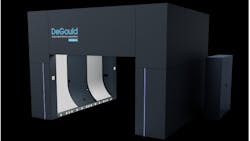In 2012, Dan Gould decided to use his background in digital imaging to find a solution to what he considered an outdated and inconsistent process for handing over and inspecting rental cars. His answer was an automated photo booth, and he founded DeGould Ltd. (Exeter, Devon, UK; www.degould.com). In 2014, Jaguar Land Rover (JLR) approached DeGould to solve a similar problem in its supply chain, and today JLR has deployed DeGould’s Auto-scan inspection product across its plants in the UK and Europe. DeGould has automated vehicle inspection solutions installed with a variety of vehicle OEMs, including its Auto-scan inspection system as well as its newest product, Auto-compact. This system combines Industry 4.0 AI damage detection with a small footprint and ultra-high-resolution image capture.
Auto-compact
DeGould’s Auto-compact is a turnkey product. The company organizes the complete package—from system build, installation, commissioning, and integration to calibrating the AI, continual software upgrades, and support after the sale. According to Ed Jones, chief commercial officer, DeGould, the system is designed to solve the issue of time-consuming and inconsistent manual vehicle inspections at OEM plants and within the finished vehicle supply chain. “Within the OEM landscape, space is often a premium,” he says. “Our compact system allows a solution to be installed over existing manufacturing lines or as a drive-through system to ensure gate quality improves while reducing warranty bills and delays to customers.”
Auto-compact consists of a variety of cameras and lighting panels to best capture defects and damage. “There are seven ultra-high-resolution cameras, two dedicated wheel cameras, and seven dent-detection mono cameras,” says Jones. “This combination of cameras ensures the exterior of the vehicle can be fully captured for damage detection. The use of different light fields ensures that all common classifications of defects can be detected automatically.” He further explains that Auto-compact has three lighting fields, including bright, dark, and structured sections. “Depending on the color of the vehicle, different types of damage will be detectable under various lighting conditions. Using all three panels gives us the best possible chance of picking up all forms of damage.” The seven ultra-high-resolution cameras, wheel cameras, and mono cameras capture the images to detect vehicle damage. The different lighting fields allow the system to capture hundreds of images in seconds, which are held in the cloud for simple access and storage, with automatic vehicle identification for reporting accuracy.
The system uses Sony (Minato City, Tokyo, Japan; www.sony.com) Alpha 7RIV cameras (61 MPixel), Alpha 9II cameras (24.2 MPixel), and Sony lenses in tandem with DeGould’s dent arch lighting system and AI algorithms to capture and analyze the images. Sony’s Camera Remote SDK allows the Alpha cameras to be integrated into DeGould’s vehicle inspection systems.
Yasuo Baba, director of digital imaging and European product marketing, Sony Digital Imaging Europe, says that DeGould uses a variety of Sony lenses for both cameras, with lens choice depending on the location of the camera within the system. The lenses used are high-quality G Master lenses in various focal lengths. Baba comments, “Our in-house sensor and imaging engine technology delivers high-speed processing and unprecedented resolution. On top of that, with Pixel Shift Multi Shooting for example, you can also reach a significant resolution improvement as well if needed.
Integrating the cameras into DeGould’s vehicle inspection systems is via the Camera Remote SDK. Baba explains that the benefit of having Camera Remote SDK is the use of API functions that were developed and verified by Sony. “This enables reliability; optimized performance, including transfer speed; and unique functions developed in combination with body firmware.” He adds that it is also backward compatible, so applications developed can be used with later SDK versions. Additionally, he says, “The SDK was developed based on the actual needs collected by industrial Alpha users, including functions like multicamera support, focus movement, etc.”
Working in conjunction with DeGould’s AI, the SDK helps the software transfer the images from the camera to a separate folder for AI processing and analysis. DeGould’s AI, according to Jones, works to identify a range of damage and defects to a vehicle’s exterior as well as perform vehicle specification checks. “The DeGould algorithm has been taught to identify all of the most common defects OEMs look for in warranty and logistics,” he says. “The data learning sets comprise more than 100 million captures of real-world vehicles in our own systems. The quality and consistency of the image acquisition is the leading enabler for our AI success.” DeGould uses a combination of edge processing and cloud-based applications to display a defect and AI data on its live dashboard.
The DeGould Dashboard is a Web-based application that allows customers to view and manage the data of all inspections completed by a DeGould system. “The dashboard combines the ultra-high-resolution images captured by our physical systems with our proprietary AI algorithms to provide a complete automated vehicle inspection report,” says Jones. “The dashboard also introduces the DeGould digital vehicle passport, which tracks a vehicle from plant to dealer via any of its own systems or alternative process to make sure digital handovers are easily tracked and any defect liability is easily resolved.”
In one application example, before deploying Auto-compact, four employees stood lineside and inspected vehicles as they passed through on a conveyor, hoping to see all defects and record them manually in less than one minute before the next car arrived. After deploying Auto-compact, inspection was automatic, and the employees standing on the line were redeployed to higher value tasks. Jones adds, “Any detected defects can now be repaired quickly and cost-effectively in the plant, which means fewer delays to customers and better route cause analysis to plant defects for a reduced incident rate.”
About the Author
Chris Mc Loone
Editor in Chief
Former Editor in Chief Chris Mc Loone joined the Vision Systems Design team as editor in chief in 2021. Chris has been in B2B media for over 25 years. During his tenure at VSD, he covered machine vision and imaging from numerous angles, including application stories, technology trends, industry news, market updates, and new products.

